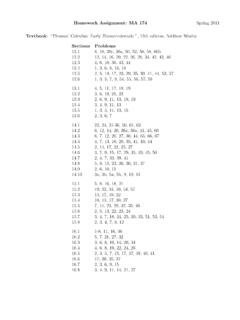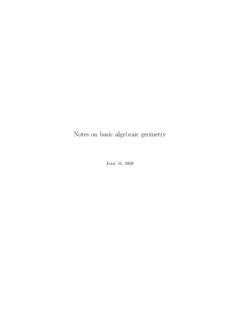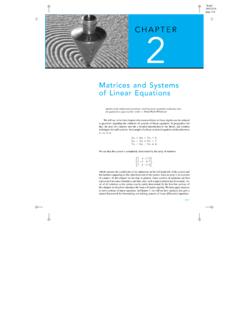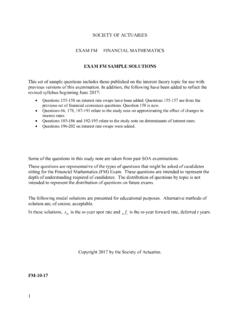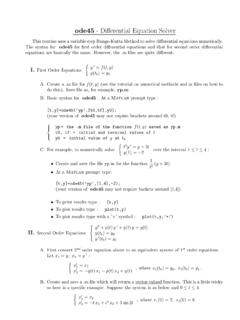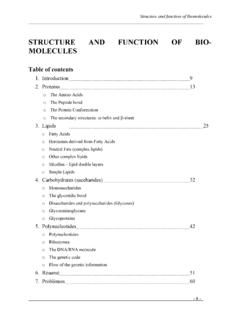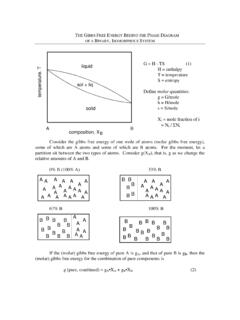Transcription of THE RIEMANN HYPOTHESIS - Purdue University
1 THE RIEMANN HYPOTHESISL ouis de Branges* proof of the RIEMANN HYPOTHESIS is to be obtained for the zeta functionsconstructed from a discrete vector space of finite dimension over the skew field of quaternionswith rational numbers as coordinates in hyperbolic analysis on locally compact Abelian groupsobtained by completion. Zeta functions are generated by a discrete group of symplectictransformations. The coefficients of a zeta function are eigenfunctions ofHecke operatorsdefined by the group. In the nonsingular case the RIEMANN HYPOTHESIS is a consequence ofthe maximal accretive property of a Radon transformation defined in Fourier analysis. In thesingular case the RIEMANN HYPOTHESIS is a consequence of the maximal accretive property ofthe restriction of the Radon transformation to a subspace defined by parity.
2 The Riemannhypothesis for the Euler zeta function is a Generalization of the Gamma FunctionThe RIEMANN HYPOTHESIS is the conjecture made by RIEMANN that the Euler zeta func-tion has no zeros in a half plane larger than the half plane which has no zeros by theconvergence of the Euler product. When RIEMANN made his conjecture, zeros were ofinterest for polynomials since a polynomial is a product of linear factors determined byzeros. Polynomials having no zeros in the upper or the lower half plane appear when thevector space of all polynomials with complex coefficients is given a scalar product definedby integration with respect to a nonnegative measure on the real vector space has an orthogonal basis consisting of a polynomialSn(z) of degreeninzfor every nonnegative integern. The polynomials have only real zeros and can be chosento have real coefficients.
3 A linear combinationSn(z) iSn+1(z) of consecutive polynomialsis a polynomial which has either the upper or lower half plane free of was familiar with examples of orthogonal polynomials constructed from hy-pergeometric series. For these special functions it happens that linear combinations ofconsecutive orthogonal polynomials have no zeros in a half plane which is larger than theupper or the lower half plane. The boundary of the larger half plane is shifted from thereal axis by a distance one RIEMANN HYPOTHESIS is contained in the issue of explaining the observed shift inzeros. There is no reason to restrict the study to orthogonalpolynomials since the efforts ofHermite and Stieltjes create a larger context. The contribution of Hermite is a class of entire*Research supported by the National Science Foundation12 LOUIS DE BRANGESA pril 13, 2017functions which like polynomials are essentially determined by zeros.
4 The contribution ofStieltjes is a treatment of integration on the real line as a representation of positive linearfunctionals on polynomials. His death from tuberculosis prevented application to theHermite class. The remaining step [1] is preparation for a continuation of their efforts onthe RIEMANN RIEMANN HYPOTHESIS for Hilbert spaces of entire functions [2] is a condition onStieltjes spaces of entire functions which explains the observed shift in zeros and whichimplies the RIEMANN conjecture if it can be applied to the Euler zeta function. Suchapplication is not obvious since the Euler zeta function hasa singularity in the proposedhalf plane of analyticity. It will be seen that the functionsatisfies a parity condition whichpermits removal of the singularity. The Euler zeta functionis an analogue of the Eulergamma function, whose properties indicate a successful treatment of the zeta gamma function is an analytic function ofsin the complex plane with the exceptionof singularities at the nonpositive integers which satisfies the recurrence relations (s) = (s+ 1).
5 A generalization of the gamma function is obtained with the factor ofsin the recurrencerelation replaced by an arbitrary function ofswhich is analytic and has positive real partin the right half analytic weight function is defined as a functionW(z) ofzwhich is analytic andwithout zeros in the upper half spaces of functions analytic in the upper half plane were introduced in Fourieranalysis by Hardy. The weighted Hardy spaceF(W) is defined as the Hilbert space offunctionsF(z) ofzanalytic in the upper half plane such that the least upper boundkFk2F(W)= sup + |F(x+iy)/W(x+iy)|2dxtaken over all positiveyis finite. The least upper bound is attained in the limit asydecreases to zero. The classical Hardy space is obtained whenW(z) is identically byW(z) is an isometric transformation of the classical Hardy space ontothe weighted Hardy space with analytic weight functionW(z).
6 An isometric transformation of the weighted Hardy spaceF(W) into itself is defined bytaking a functionF(z) ofzinto the functionF(z)(z w)/(z w )ofzwhenwis in the upper half plane. The range of the transformation is the set ofelements of the space which vanish atw. A continuous linear functional on the weightedHardy spaceF(W) is defined by taking a functionF(z) ofzinto its valueF(w) atwwheneverwis in the upper half plane. The functionW(z)W(w) /[2 i(w z)]THE RIEMANN HYPOTHESIS3ofzbelongs to the space whenwis in the upper half plane and acts as reproducing kernelfunction for function values Hilbert space of functions analytic in the upper half plane which has dimensiongreater than one is isometrically equal to a weighted Hardy space if an isometric transfor-mation of the space onto the subspace of functions which vanish atwis defined by takingF(z) intoF(z)(z w)/(z w )whenwis in the upper half plane and if a continuous linear functional is defined on thespace by takingF(z) intoF(w) forwof the upper half of weighted Hardy spaces are constructed from the Euler gamma analytic weight functionW(z) = (s)is defined bys=12 maximal accretive transformation is defined in the weighted Hardy spaceF(W)
7 BytakingF(z) intoF(z+i) whenever the functions ofzbelong to the linear relation with domain and range in a Hilbert space is said to be accretive if thesumha, bi+hb, ai 0of scalar products in the space is nonnegative whenever (a, b) belongs to the graph of therelation. A linear relation is said to be maximal accretive if it is not the proper restriction ofan accretive linear relation with domain and range in the same Hilbert space. A maximalaccretive transformation with domain and range in a Hilbertspace is a transformationwhich is a maximal accretive relation with domain and range in the Hilbert maximal accretive transformation is defined in a weighted Hardy spaceF(W)by takingF(z)intoF(z+i)whenever the functions ofzbelong to the space if, andonly if, the functionW(z 12i)/W(z+12i)ofzadmits an extension which is analytic and has nonnegative real part in the upperhalf of Theorem Hilbert spaceHwhose elements are functions analytic in theupper half plane is constructed when a maximal accretive transformation is defined inthe weighted Hardy spaceF(W) by takingF(z) intoF(z+i) whenever the functions ofzbelong to the space.
8 The spaceHis constructed from the graph of the adjoint of thetransformation which takesF(z) intoF(z+i) whenever the functions ofzbelong to elementF(z) = (F+(z), F (z))4 LOUIS DE BRANGESA pril 13, 2017of the graph is a pair of analytic functions ofz, which belong to the spaceF(W), suchthat the adjoint takesF+(z) intoF (z). The scalar producthF(t), G(t)i=hF+(t), G (t)iF(W)+hF (t), G+(t)iF(W)of elementsF(z) andG(z) of the graph is defined as the sum of scalar products in the spaceF(W). Scalar self products are nonnegative in the graph since the adjoint of a maximalaccretive transformation is elementK(w, z) of the graph is defined byK+(w, z) =W(z)W(w 12i) /[2 i(w +12i z)]andK (w, z) =W(z)W(w+12i) /[2 i(w 12i z)]whenwis in the half plane1< iw identityF+(w+12i) +F (w 12i) =hF(t), K(w, t)iholds for every elementF(z) = (F+(z), F (z))of the graph.
9 An element of the graph which is orthogonal to itself is orthogonal to everyelement of the isometric transformation of the graph onto a dense subspace ofHis defined bytakingF(z) = (F+(z), F (z))into the functionF+(z+12i) +F (z 12i)ofzin the half plane1< iz reproducing kernel function for function values atwin the spaceHis the function[W(z+12i)W(w 12i) +W(z 12i)W(w+12i) ]/[2 i(w z)]ofzin the half plane whenwis in the half byW(z+12i) is an isometric transformation of the spaceHonto a HilbertspaceLwhose elements are functions analytic in the half plane andwhich contains thefunction[ (z) + (w) ]/[2 i(w z)]ofzas reproducing kernel function for function values atwwhenwis in the half plane, (z) =W(z 12i)/W(z+12i).THE RIEMANN HYPOTHESIS5A Hilbert space with the same reproducing kernel functions is given an axiomatic char-acterization in the Poisson representation [1] of functions which are analytic and havepositive real part in the upper half plane.
10 The argument applies to the present spaceLwhose elements are functions analytic in the smaller half function[F(z) F(w)]/(z w)ofzbelongs toLwhenever the functionF(z) ofzbelongs toLifwis in the smallerhalf plane. The identity0 =hF(t),[G(t) G( )]/(t )iL h[F(t) F( )]/(t ), G(t)iL ( )h[F(t) F( )]/(t ),[G(t) G( )]/(t )iLholds for all functionsF(z) andG(z) which belong toLwhen and are in the smallerhalf isometric transformation of the spaceLinto itself is defined by taking a functionF(z) ofzinto the functionF(z) + (w w )[F(z) F(w)]/(z w)ofzwhenwis in the smaller half same conclusion holds whenwis in the upper half plane by the preservation of theisometric property under iterated compositions . The elements ofLare functions whichhave analytic extensions to the upper half plane. The computation of reproducing kernelfunctions applies whenwis in the upper half plane.
